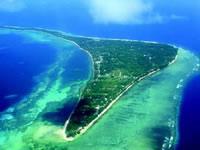Republic of Marshall Islands: Integrated water management and development plan for Laura groundwater lens, Majuro Atoll
Aims: To improve water resources management, reduce groundwater pollution and improve water supply around the Laura area
Activities: Provision of wastewater, sanitation, solid waste and recycling facilities; Repair Maintenance of infrastructure for groundwater supply; Water resource use planning and monitoring using Geographic Information System (GIS); establishment of a Laura Lens Integrated Water Resource Plan.
"3(a) INDICATOR#1: REDUCTION IN SEWAGE POLLUTION IN LAURA COMMUNITY
At the time of project inception, there was no system in place for reducing sewage pollution in Laura. Many household septic systems were overloaded and broken. The target of the project was to have 35 percent reduction in sewage pollution of the lens from households. The survey of septic waste identified 117 broken and overloaded septics requiring immediate pump-out. To date around 4% of these septics have been remediated. "
"2(a) INDICATOR#1: BEST IWRM AND WUE APPROACHES DEFINED
Prior to project inception a consultant had been engaged to identify IWRM and WUE needs for the Marshall Islands. Although these had not been considered by communities or relevant agencies of government. The target was to have the approach defined and endorsed by national APEX body. Via the operation of a national consultation process, involving communities and women’s groups, priorities for and steps towards institutionalizing IWRM approaches in the RMI have been developed and endorsed by the National IWRM Task Force.
2(b) INDICATOR#2: INCREASE IN COMMUNITY ENGAGEMENT WITH NATIONAL GOVERNMENT ON WATER ISSUES
At the time of project inception, the relationship with the Laura community and national government was tenuous due to a history of dispute over water resource access and allocation. Prior to project commencement, only 2 community group representatives occasionally took part in government workshops. Regular engagement of traditional leaders, landowners, and Laura residents with government through the operation of the community-based Laura Lens Committee has assisted with developing a common understanding and trust between the community, with on average 12 community leaders meeting on a quarterly basis with government.
2(c) INDICATOR#3: MULTI-SECTORAL APEX BODY IN PLACE
At the time of project inception, there was no APEX body for water in the RMI. The target of the
project was to have such a body established and operational by July 2010. RMI’s National IWRM
Task Force was established by Executive Order and includes membership off all relevant community
and traditional leaders, national government departments, local governments, private sector and
NGOs. The Task Force is actively leading coordination, policy development, and planning. "
| Photo | |
|---|---|
 |
|
| Data | |
|---|---|
| Year | 2012 |
| Reporting date | 14-Mar |
| Related sites |
|---|
|
Ridge to reef: protecting water quality from source to sea in the Federated States of Micronesia
Improved catchment management
Environmental and socio-economic protection in Fiji: Integrated flood risk management in the Nadi River Basin (site 2)
Improved catchment management
Tonga: Improvement and Sustainable Management of Neiafu; Vava’u’s Groundwater Resource
Pollution Reduction to Aquifers: N
Integrated Sustainable Wastewater Management (Ecosan) for Tuvalu
Municipal Wastewater Pollution: N
Integrated Sustainable Wastewater Management (Ecosan) for Tuvalu (site 2)
Water Use Efficiency
Integrated Sustainable Wastewater Management (Ecosan) for Tuvalu (site 3)
Water Use Efficiency
Vanuatu: Sustainable Management of Sarakata Watershed (site 2)
Improved catchment management |

























